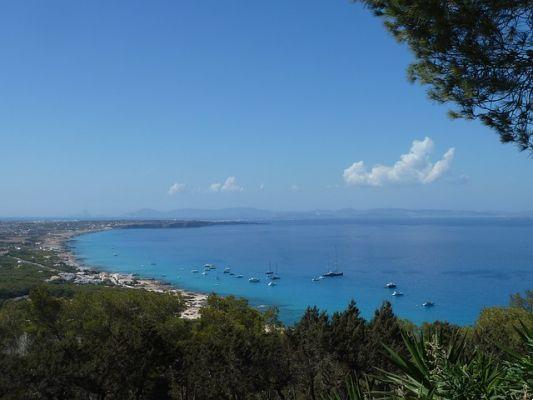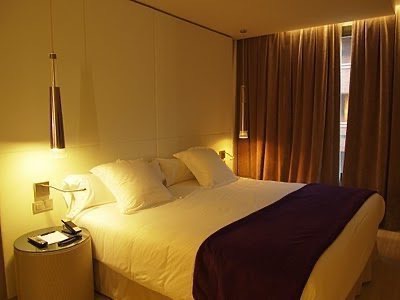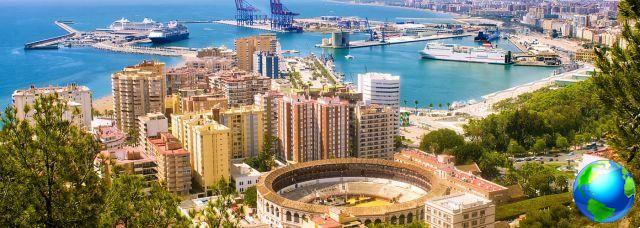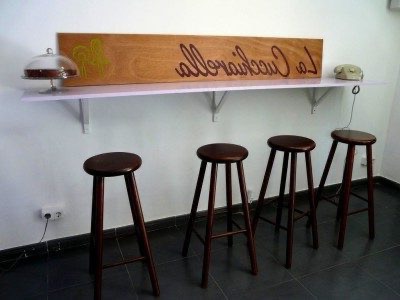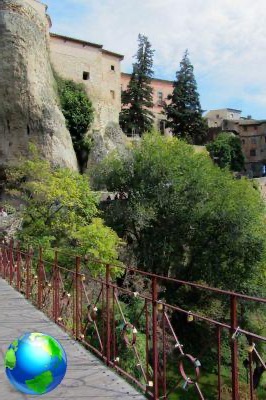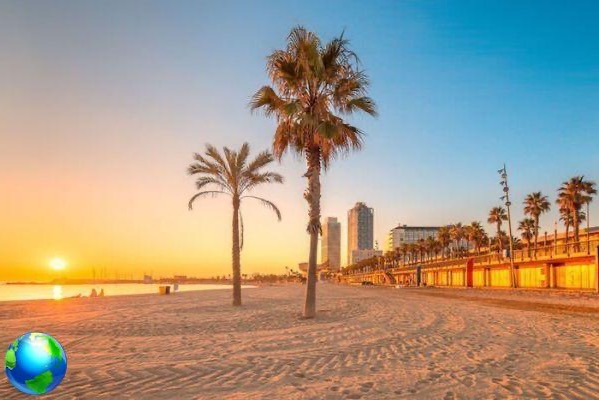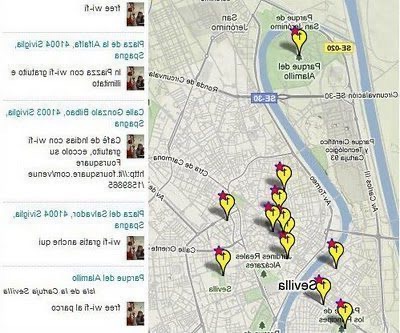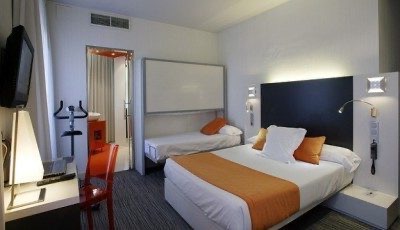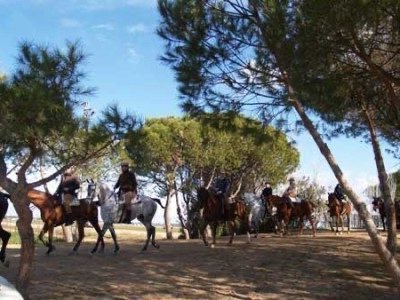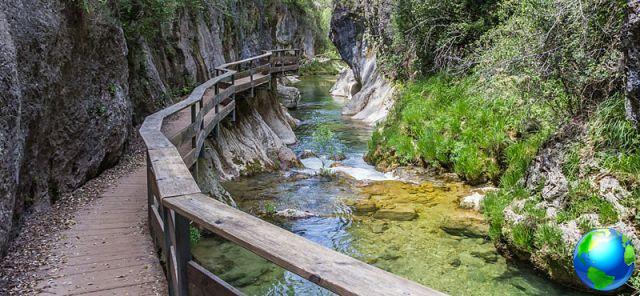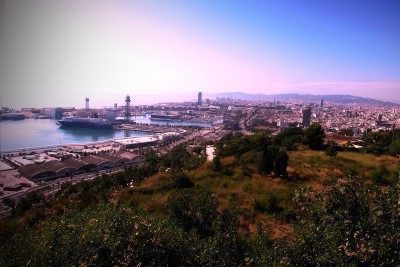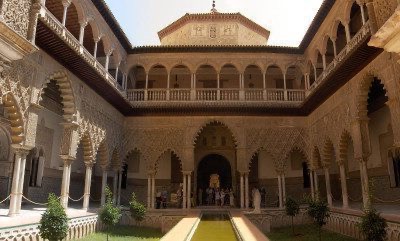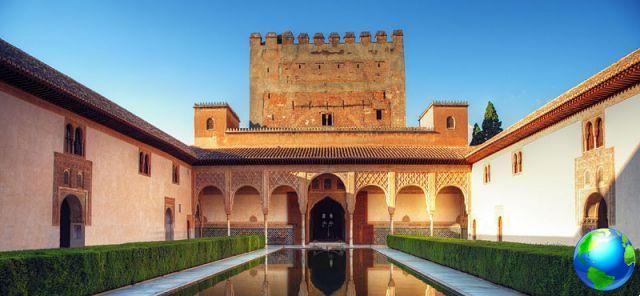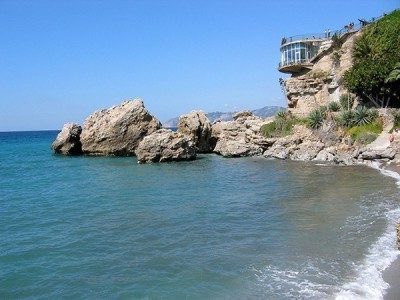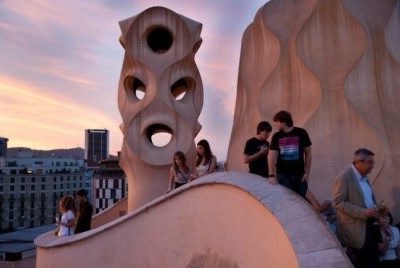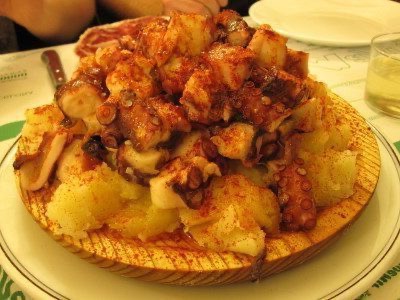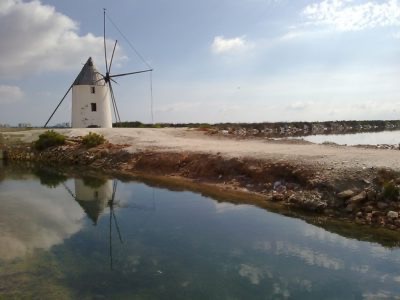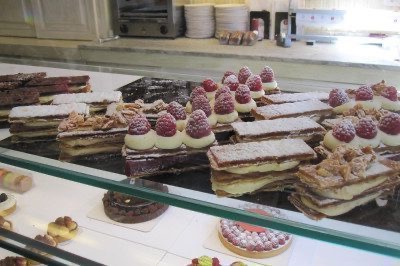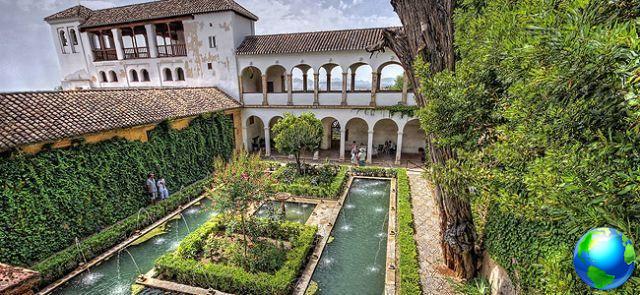
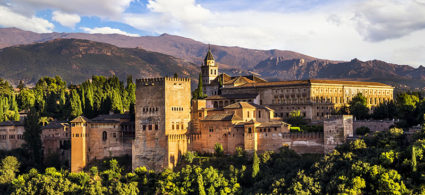
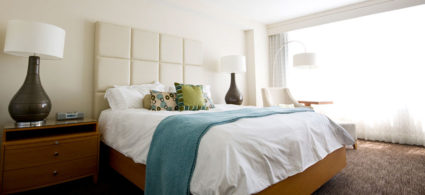
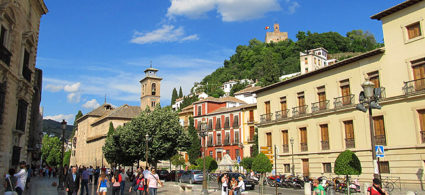



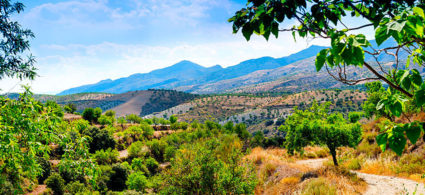
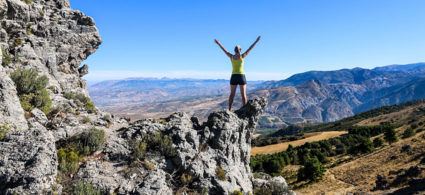
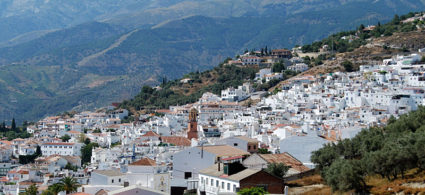
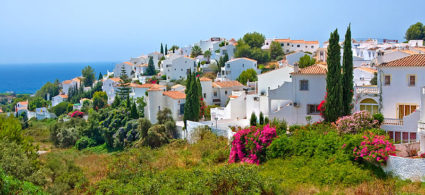
The monumental city of Granada, founded by the Romans with the name of Illibris between the Darro and Geni rivers, lies at the foot of the Sierra Nevada, between the shores of the Mediterranean and the Andalusian hinterland, and is famous for its Hispano-Middle Eastern charm.
In city centre there are numerous Nazari-style buildings, Arab baths and the winding Moorish quarter of Albaicín, but the wonder of Granada, and its most famous monument, is undoubtedly the Alhambra, the impressive Arab fortress, full of ornate palaces and surrounded from green. Together with the Generalife gardens and the Albayzin, the Alhambra was declared UNESCO World Heritage Site.
In addition Granada boasts a Renaissance cathedral dating back to the 16th century around which there are numerous testimonies of the Moorish, Jewish and Catholic past of the city. In addition to its historical and architectural beauties that tell more than a thousand years of history, Granada It has a lively nightlife university and numerous and participatory events, both religious and secular.
La gastronomy of Granada it is rich and diverse and in itself is a reason to visit the city. You will find a large number of restaurants and bars where you can enjoy succulent dishes such as migas, remojón, broad beans with jamón, Sacromonte omelette and gazpacho. The most popular areas for tapas are Albaicín, Campo del Príncipe, Realejo, Plaza de Toros and the Centro.
The playwright and writer Federico Garcia Lorca is the most famous from Granada, he was killed by a firing squad in a village near Granada during the bloody Spanish civil war of 1936-39.
What to see in Granada
Granada is a city fromimportant architectural heritage which includes a Moorish essence, some Renaissance jewels and modern and contemporary structures. Most of Granada's tourist attractions are located near the city center and are easily accessible.
In addition to medieval part of the city, which is located on two adjacent hills and which includes two sites declared World Heritage by Unesco, namely the Alhambra fortress and the Moorish quarter Albaicín, where traditional Andalusian architecture fits harmoniously, Granada offers a lot to visitors.
Do not miss the magnificent Generalife gardens, the Alcaiceria, a handicraft market where you can admire the carved arcades of the Arab souq, largely rebuilt after the fire in 1843, Plaza Bibarrambla and the Gigantones fountain, Plaza Nueva, with the facade of the royal chancellery dating from the 16th century, and the Church of Santa Ana. In the Arab quarter visit Casa de Castril, Casa de Porras, and El Bañuelo, the old Arab baths.
Also very beautiful are the Cathedral of Granada, in Gothic-Renaissance style, the Royal Chapel, adjacent to the Cathedral and considered the most important Christian monument in the city, the Monasterio de la Cartuja and the Monasterio di San Jeronimo,
A a few minutes from Granada there is the house of Garcia Lorca where the writer has created some of his most prestigious works. In the house are still kept some personal objects of the artist such as the piano, the desk and some drawings. Outside the house there is the Parque Federico Garcia Lorca.
The Center of Granada
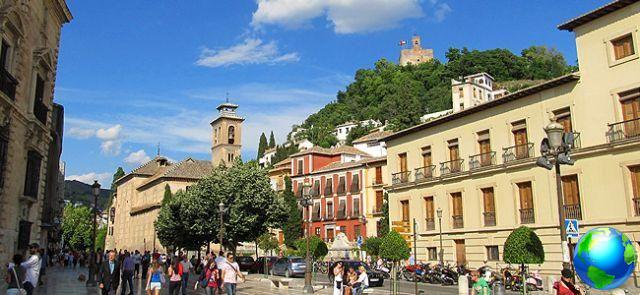
Il center of Granada is the beautiful Plaza Nueva. From here you reach Plaza Santa Ana and its Iglesia de Santa Ana recognizable by the minaret of a previous mosque. Following Carrera del Darro you will reach Banos Arabes El Banuelo and the Archaeological Museum. Climbing up the winding streets of the Albaicín you come to the Colegiata del Salvador, a XNUMXth-century church built over the neighborhood's main mosque.
Nearby are also the Arco de las Pesas, gateway to the Albaicín dating back to the XNUMXth century, the Mirador San Nicolas, from where you can admire the fantastic Sierra Nevada, and the Mezquita Mayor de Granada. Going down towards Placeta de San Miguel Bajo you can stop at one of the many cafes and restaurants and then visit the Palacio de dar-al-Horra, the fifteenth-century residence of the last ruler of Granada.
Finally, reach Calle Caldereria Nueva, the street of the teterias, the famous Middle Eastern tea rooms, and North African souvenir shops.
Where to eat in Granada
Many ristoranti in Granada they offer the opportunity to taste the typical cuisine of the region, wonderfully blended with Arabian flavors and especially spices. Among the dishes not to be missed are the rabo de toro, bull's tail stew, las habas with jamon, fried broad beans and ham, the Sacromonte tortilla, special omelette with veal brains and bull testicles, and finally the gazpacho and pipirrana.
The variety of the kitchen of Granada is also due to the diversity of its territory. From the cold inland mountains comes the Olla di San Anton from Sierra Nevada, pork with dried broad beans, rice and fennel, the ham from Trevélez, one of the highest villages in Spain, and the Plato Alpujarreno, a set of salami, sausage , loin, fried eggs, goat cheese and potatoes.
The tasty ones come from the warm Costa Tropical seafood dishes: scampi, white prawns from Motril, bream, sardines, sea bass, sea bream and other Mediterranean delicacies. The mild and warm climate of this land has also favored the cultivation of numerous exotic fruits such as mango, chirimoya and avocado.
For lovers of Tapas, magnificently seasoned with fine local oils, in Granada there is still the habit of serving them for free to accompany a tinto wine or a cerveza.
The sweets
Most sweets of Granada are made with honey and spices, ingredients left in inheritance from the Arab culture. Among the most popular and well-known we recommend the exquisite tocillinos de cielo from Guadix, the piononos from Santa Fe, the fig bread from the Alpujarra, the donuts from Loja and finally the numerous biscuits with eggs and jams.
How to get to Granada
By plane
Granada Airport is located approximately 18 kilometers from the city center and is well connected by buses and taxis. If you have your own vehicle, take the A-92 motorway to reach Granada airport and follow the signs.
By bus
Granada's bus station is located approximately 3 kilometers northwest of the center. Granada is well connected with the following cities: Cordoba in 3h00, Seville in 3h00, Malaga in 1h30, Las Alpujarras and Guadix in 1h00, Madrid in 6h00 and Barcelona in 10h00.
By car
Getting to Granada comfortably by car is very simple.
- From Seville
From the N-IVb take the A-92 until the exit for the A-329. Follow the signs for the N-432a and N-323a until you reach Granada.
Km: 250 - Yes Cordoba
From the N-432 take exit 408 and merge onto the A-45 towards Malaga and then take the A-92. Take exit 241A and continue on the E-902 / A-44 towards Granada. Finally take exit 129 towards Recogidas.
Km: 160 - Da Malaga
Take the A-45 and join the A-92 towards Granada. Take exit 241A and continue on the E-902 / A-44 towards Granada. Finally take exit 129 towards Recogidas.
Km: 135
By train
How to get around Granada
To visit and learn more about a city of Granada, the best solution is to walk through its streets and discover its most hidden corners. The main streets are Gran Via de Colon and Calle Reyes Catolicos which intersect in Plaza Isabel La Catolica while Calle Reyes Catolico joins Plaza Nueva and Puerta Real. The Alhambra is connected to Plaza Nueva by Cuesta de Gomérez. The Arab quarter Albaicín is a maze of narrow streets to be discovered.
By bus
At the Granada Tourist Office you can find out about the timetables and routes of the various local bus lines in Granada, all of which are red in color. In addition to the ticket valid for a single journey, other forms of season tickets are also available.
- To get to the bus station from the center, Gran Via de Colon, take buses 3, 4, 6, 9 or 11.
- To reach the train station take bus 4, 6, 7, 9 or 11 from Avenida de la Constitucion.
- To reach the Alhambra take bus 32.
- To reach Albaicín, take bus 31.
Tourist Bus
To visit Granada quickly you can take a tour of the city with the typical tourist buses. Usually the ticket is valid for 24 hours and allows you to get off and on at any stop located at the most important places to visit. During the journey it is also possible to request headphones to listen to the multilingual guide.
By car
Most of the center of Granada is pedestrianized and vehicle access to the Plaza Nueva area is limited by the pilonas, temporary posts that prevent access. If you are staying in a hotel near Plaza Nueva, you can contact the reception who will lower the pilonas.
Nightlife in Granada
Granada is a city ideal for having fun, its clubs are always full of young students and tourists and often offer live music and flamenco shows.
To find out about the programs of all the clubs in Granada, you can buy the monthly Guia de Granada or the fortnightly Yuzin at the newsstands and finally go to the foyer of La Madraza, in Calle Oficios in front of the Royal Chapel, where you can read the cultural events scheduled in Granada.
Locations
- Chestnut Wineries, Almireceris Street
- Old Castaneda, Elvira Street
- The Circle, Elvira Street
- Cafe Bar Elvira, Calle de Elvira 85
- Anais Cafe, Bensuceso Street
Pubs and discos
- Industrial Copera, Armilla Road
- Granada 10, Lower Jail Street
- Ground Floor, Calle Horno de Abad 11
- Aphrodisia, Almona del Boqueron Street
Flamenco
- The Eshavira, Postigo de la Cuna 2
- The Upsetter, Carrera del Darro 7
- Pena de la Planteria. Placeta de Toqueros
- The Tarantos, Path of Sacromonte
Theater
- Manuel de Falla Cultural Center, Paseo de los Matires
- Alhambra Theater, Calle de Molinos 56
- Isabel La Catolica Theater, Acera del Casino
Spanish courses in Granada
Granada is one of the main university centers in all of Spain and is therefore inhabited by many students, especially foreigners, who follow the Erasmus university program, and boasts excellent Spanish language schools, but also dance, especially flamenco.
There are many Spanish language schools to choose from and which belong to the association of Spanish schools of Andalusia, the Aeea, accredited by the'Cervantes Institute, a non-profit organization created by the Spanish government in 1991 with the mission of promoting the teaching of Spanish and the co-official languages of Spain, as well as contributing to the dissemination of the country's culture.
Choose from the wide variety of coursesIn terms of type and lessons per week, take part in the great variety of activities organized by the schools including excursions to Seville, Cordoba and the Costa Tropical.
What to buy in Granada
Shopping in Granada is very beautiful and relaxing. Among the typical handicraft products of the city, the famous glazed ceramics with the colors of Granada and the objects made of teracea, a typical inlay of the city, used by artisans to create wonderful tables enriched with silver, ivory and mother of pearl with original geometric motifs deserve a mention. .
- Ceramica Fabre, in Calle Pescaderia
- Inlaid Workshop Lagoon
souvenir
In the souvenir shops of Alcaiceria, Albaicín, Plaza Nueva and Cuesta de Gomerez and in the state shop of Corral del Carbon you can buy handicrafts made of leather, wrought iron, brass and copper, guitars for flamenco, fabrics, ethnic clothing, baskets and jewels.
If you are looking for some trendy clothing, visit the boutiques on Calle de los Mesones, Inns, Puentezuelas and Raccolte, or head to the El Corte Inglés department store.
Shop opening hours
Small shops are usually open from 10.00 to 13.30 and from 17.00 to 20.30. The large branded shops, on the other hand, open all day from 10.00 to 20.30. Finally, the shopping centers are open from 10.00 to 22.00.
The markets of Granada
Important markets in Granada are that of Almanjayar, every morning until 15 pm, the market of the La Chana district, every Wednesday, and the market of the Zaindin district, every Saturday. The Albaicería and Bazar markets are also very characteristic, where it is possible to buy the typical objects of the Arab and Jewish tradition of Granada.




